The MacBook Pro Review (13 & 15-inch): 2011 Brings Sandy Bridge
by Anand Lal Shimpi, Brian Klug & Vivek Gowri on March 10, 2011 4:17 PM EST- Posted in
- Laptops
- Mac
- Apple
- Intel
- MacBook Pro
- Sandy Bridge
Thermals and Power Consumption
The new MacBook Pros have the potential to draw more power than the previous generation. Despite being built on a 32nm process, the new 15 has twice the cores of last year's model—there's no question that it can draw more power under a full load.
I measured maximum power consumption at the wall using the same power brick and a fully charged battery. I chose two high-load scenarios: Cinebench 11.5 and Half Life 2. The former will fully load all CPU cores while the latter ramps up CPU and GPU usage.
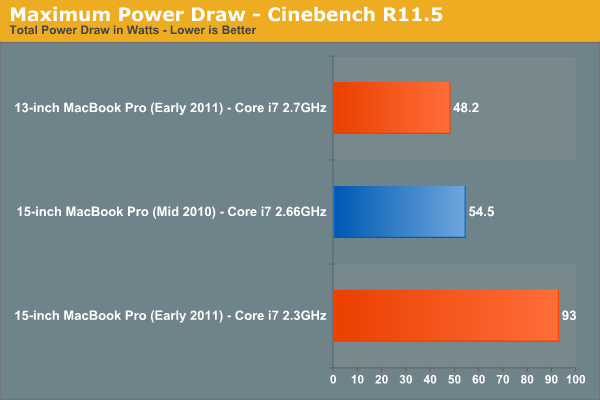
Under Cinebench the new quad-core 15-inch MacBook Pro draws 70% more power at the wall than last year's dual-core model. This shouldn't be surprising as Cinebench scales nearly perfectly with core count—twice the cores should result in nearly twice the power draw. The scaling isn't perfect since we are dealing with different architectures and a number of factors such as display remain static. The new 13-inch MacBook Pro isn't as worrisome, it has 88% of the power usage of the high end 2010 15-inch MBP and 81% of the battery capacity.
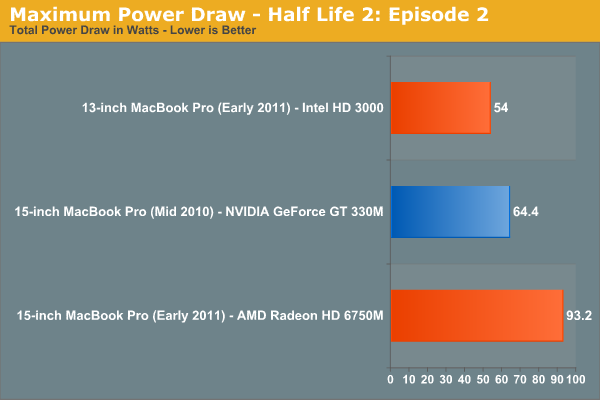
The Half Life 2 comparison is not quite as bad, although the new 15-inch MBP still uses 45% more power under full load compared to the previous generation. These numbers tell you one thing: although the new MBP is significantly faster than its predecessor, it can also draw significantly more power. Running the same workload the new MBP shouldn't have any problems lasting as long as the old MBP on battery, but running a more aggressive workload will result in shorter battery life as a result of the higher max power consumption. In other words if you use the higher performance to do more, you can expect your battery to last proportionally less than the 2010 MBP.

The 15-inch MBP uses an 85W power adapter (left) and the 13-inch MBP uses a 60W adapter (right)
Drawing more power also has another unfortunate side effect: the bottom of the chassis gets even hotter than before. I took some crude temperature measurements when I did the 2010 MacBook Pro reviews last year. I pointed an IR thermometer at the center of the bottom of the notebook, right where you'd have your lap, and measured surface temperature in a couple of scenarios.
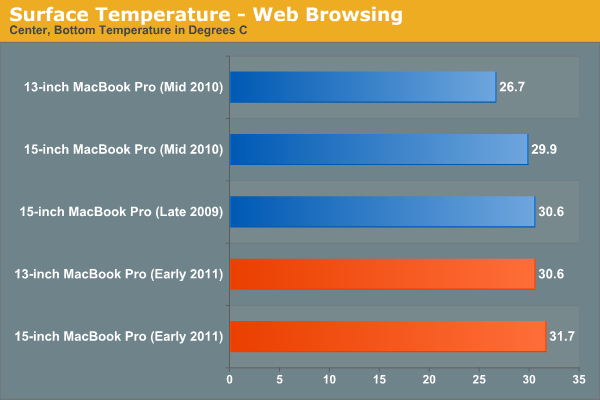
While browsing the web with tons of windows/tabs open I noticed a small but tangible increase in surface temperature of the 2011 15-inch MBP compared to the 2010 model. Even the new 13 is warmer than last year's 15. Under light workloads none of these temperatures are high enough to really be a problem.
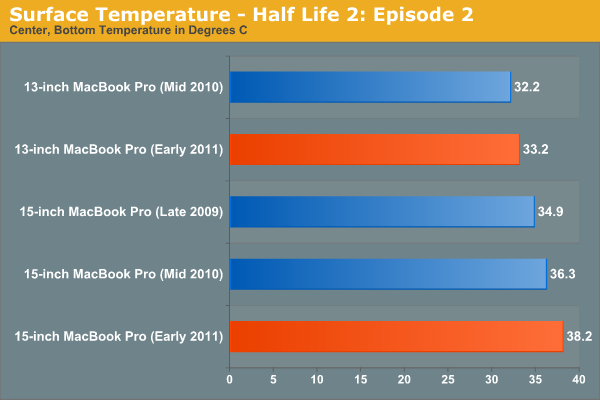
Load up the system however and you start getting into the uncomfortable zone. The new 15 breaks 38C, while the new 13 is actually only marginally warmer than the old 13 thanks to the use of Intel's HD Graphics 3000.
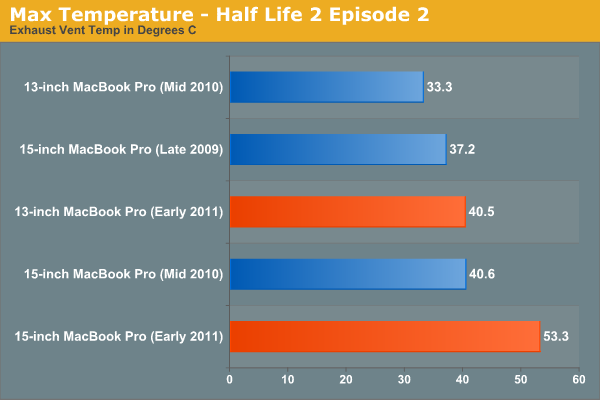
The biggest difference I noticed was the max temperature near the exhaust fan(s) on the notebooks. The new 15 is a whole 13C warmer than last year's model.
There's no way to get around it—if you're going to be using these systems to anywhere near their potential, they are going to get significantly warmer than last year's. Also, as a result, the new systems are noisier. Fans are more likely to spin up and given how small they are, they are quite audible. If this is a deal breaker for you, the best advice I can give you is to wait for Ivy Bridge.

Ivy Bridge will bring mild updates to the Sandy Bridge architecture, an increase in performance but more importantly it'll bring Intel's 22nm process. At 22nm I'd expect somewhat lower power usage than what we're seeing here today. Ivy Bridge is expected to ship in the first half of 2012, with updated MacBook Pros arriving ~2 months post introduction.










198 Comments
View All Comments
jb510 - Friday, March 11, 2011 - link
It would seem to me their is one currently shipping Thunderbolt periphral... A 2011 MBP in target disk mode. Maybe you could drop an SSD in one and do some preliminary testing?jb510 - Friday, March 11, 2011 - link
damn... wish i could edit that comment originally typed on my iphone... but their doesn't appear to be any way... (misspelling repeated for comedic effect)deadshort - Friday, March 11, 2011 - link
Thanks for the genuinely informative review. Running both low-load and high-load battery tests is especially helpful to developers, etc.One question. You chose the 2.3Ghz/8MB cache system. Was that just 'cuz you swing that way, or do you expect significant performance benefits for some workload you care about? For these machines is it a 10% price goldplate, or a reasonable increment to keep these CPUs fed? I am seriously interested....
Brian Klug - Friday, March 11, 2011 - link
I can speak for myself at least, but part of the reason for the 2.3/8 MB system choice was that it's the only preconfigured (Apple Store available) configuration that comes with the anti-glare display.Essentially, if you're a customer walking into the apple store and don't want the glossy/glare display, you're immediately forced into buying the highest-specced (and most expensive) MacBook Pro. It's frustrating because the only way to get lower specced systems is BTO online.
Obviously we got these systems on launch date to immediately start working, and that was the reason for the 2.3 choice.
-Brian
synaesthetic - Friday, March 11, 2011 - link
You know, I don't get this thin crap. I really don't.I mean, I can understand it. From a purely aesthetic point of view. Sort of, anyway.
I'm sick of "thin" gadgets with weak performance and fragile builds. Thick gadgets means more tech fits inside. My HTC Glacier is quite thin, and you know what? I wish it was thicker. It'd be easier to hold onto, and HTC could have put a bigger battery in it!
Stop making things so stupidly thin. Instead of driving the miniaturization of components on "thin," why not take that same miniaturization power and make things a bit thicker... with more power/cooling/battery inside?
Thin may be sexy, but powerful is even sexier!
Then again, Apple's never really cared to broadcast the specs of their devices, hoping instead to gloss over it to such a degree that nobody questions paying ridiculously inflated prices...
Marc B - Friday, March 11, 2011 - link
I am finally buying my first MacBook this year, and I am 70/30 leaning toward the 15" MBP. The 17" version has the high res screen and express port, but the 15" MBP is lighter/smaller and has the SDXC reader. Will the Thunderbolt port will provide enough throughput to allow simultaneous in/out?I am using this to log HD video on location, and was wondering if the express port is no longer necessary to use with a small ESATA array now that you can have high speed storage in and out using the Thunderbolt port.
Belard - Friday, March 11, 2011 - link
If Apple is pushing their notebooks to be more and more Desktop replacements...Where is a docking bay to handle all the connectors? How hard for a single connector to handle everything?
Lenovo sells about 3 different Docking units $130~300 for their regular Thinkpad line (ie: NOT Edge or L/SL series).
We have a few users who use them. Comes to the office, drop the notebook into the dock and turn it on, not a single cable to be attached. They include 4 USB ports (or more), PS/2 ports, HDMI and DVI ports, Ethernet and of course charge up the battery.
So one user would have to plug in 7 cables everyday if he didn't have a dock... like his keyboard, wireless desktop mouse, 21" display, various printers and devices, etc.
name99 - Friday, March 11, 2011 - link
" I still haven't figured out how to actually grab SINR out on here, all I can see for the moment is just RSSI. "Apple's Airport Utility does give you part of what you want.
If you open it, go to "Manual Setup", see the summary page, and click on where it says "Wireless Clients: 2" (or 3 or whatever) you will be given a page that, for each connection, shows their signal and noise levels (along with a graph).
Of course this doesn't exactly have any bearing on what we are discussing, because the numbers that are presented are the intermediate term SINR values, relevant to shadowing but not to fading. The numbers that are relevant to fading (and thus to MIMO tricks) change on a millisecond time scale, and so what one really wants is an indication of their standard deviation, along with other info like the connection diversity. This is all way more geeky than Apple (or any other consumer company) is going to provide.
humunculus - Friday, March 11, 2011 - link
Any chance you could run a few of the tests on the 2.0 and 2.2 GHz models. I am interested in how much performance difference there is between the 2.2 and 2.3 GHz 15 inch Macbook Pro models. It is hard to assess if the 10% cost increase is warranted. ThanksBelard - Saturday, March 12, 2011 - link
The $400 price difference is for the extra 200mhz (Apple values that at $250 - these are notebook CPUs, so pricing from intel is a factor)And then $150 to sometimes double the performance of the GPU for games.
Oh, and an extra 250GB of HD space (which is about $5 in the real world).